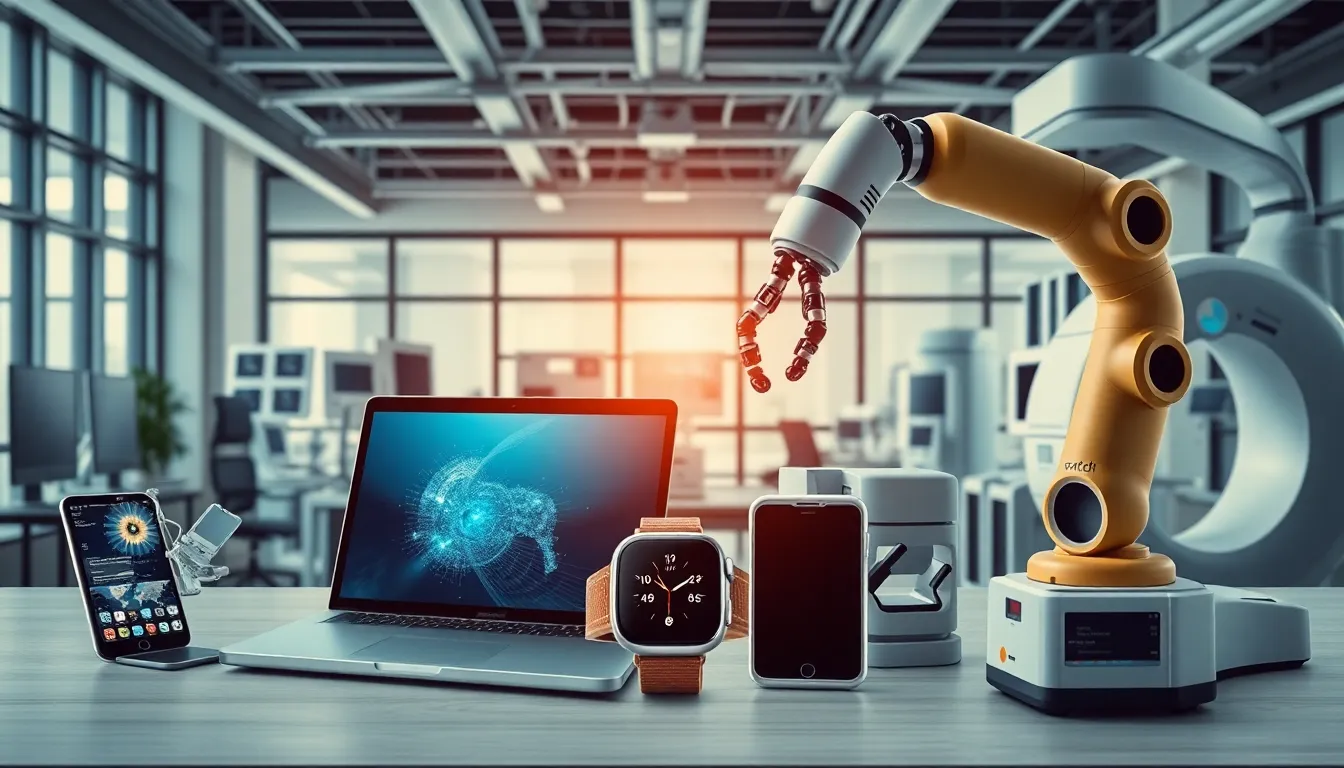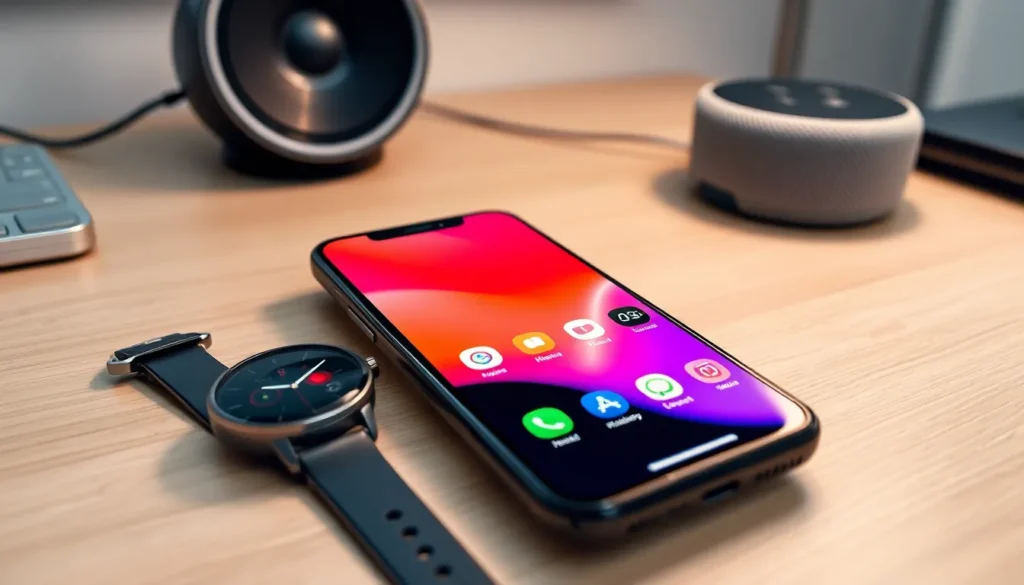In today’s tech-savvy world, powered devices are the unsung heroes of modern life. From smartphones that fit in your pocket to smart home gadgets that obey your every command, these devices are making life easier, one charge at a time. But with so many options out there, how do you separate the must-haves from the “meh”?
Table of Contents
ToggleOverview of Powered Devices
Powered devices significantly influence daily routines, offering enhanced convenience and efficiency. Smartphones exemplify this trend, providing communication, navigation, and entertainment capabilities. Smart home gadgets contribute by automating tasks, such as controlling lighting and adjusting thermostats.
Wearable technology, like fitness trackers and smartwatches, plays a pivotal role in monitoring health. These devices empower users to track steps, sleep patterns, and heart rates. Laptops and tablets also exemplify powered devices, bridging work and leisure seamlessly.
Consumers often choose devices that integrate with existing ecosystems. A smart speaker, for example, operates in harmony with other smart devices, creating a cohesive environment. Home security systems, featuring cameras and alarms, enhance safety, providing peace of mind for users.
Electric vehicles represent a growing category of powered devices. They reduce carbon footprints while offering modern features like autonomous driving and energy-efficient travel. Portable chargers and power banks enable users to keep devices powered on the go.
Powered devices vary widely in capability and impact. Some serve essential functions, while others cater to niche interests. Evaluating the necessity and functionality of each device aids in making informed choices. In today’s technology-driven world, understanding the role of powered devices shapes better decision-making.
Types of Powered Devices

Powered devices come in various categories, each designed to enhance specific aspects of daily life and industry. Understanding these types helps evaluate their importance and functionality.
Consumer Electronics
Consumer electronics encompass devices like smartphones, tablets, laptops, and smartwatches. Smartphones enable users to communicate easily and access information anytime, while tablets offer a larger screen for streaming and browsing. Laptops combine work and leisure functionalities, making them versatile tools for professionals and students. Smartwatches provide real-time health tracking, integrating seamlessly with smartphones. These devices prioritize connectivity and convenience in everyday activities, appealing to diverse user needs.
Industrial Equipment
Industrial equipment powered by advanced technology serves essential roles in manufacturing and logistics. Machines such as robotic arms automate repetitive tasks, improving efficiency and accuracy on production lines. Automated guided vehicles simplify material transport, optimizing workflow in warehouses. CNC (computer numerical control) machines execute precise machining operations with minimal human intervention. Each industrial powered device enhances productivity, reduces labor costs, and ensures safety in high-risk environments.
Medical Devices
Medical devices contribute significantly to patient care and diagnosis. Devices like MRI machines and ultrasound equipment provide critical imaging for medical assessments. Wearable health monitors detect vital signs continuously, enabling remote patient management. Infusion pumps ensure accurate medication delivery, improving treatment protocols in hospitals. These powered devices prioritize patient safety and aid healthcare professionals in making informed decisions about treatment and care.
Key Features to Consider
When evaluating powered devices, several critical features emerge as essential for a satisfactory user experience. These aspects directly impact functionality and overall satisfaction.
Battery Life
Battery life remains a top priority for many users. Devices with longer-lasting batteries provide the freedom to roam without constant recharges. Consider products with at least 10 hours of usage on a single charge, ensuring productivity throughout the day. Checking for quick-charging options gives added convenience for busy lifestyles. Users often prefer devices that can deliver efficient power management, reducing energy waste while maximizing performance.
Portability
Portability greatly influences device choice in today’s fast-paced world. Lightweight devices make it easy to carry while on the go. A sleek design coupled with a compact build ensures that devices fit comfortably in bags or even pockets. Many users appreciate tablets and laptops that function well in various environments, from coffee shops to outdoor settings. Assessing dimensions and weight helps determine whether a device meets individual mobility needs.
Performance
Performance defines the user experience with powered devices. High processing power enables smooth multitasking and quick response times. Devices equipped with advanced processors offer superior graphics and enhanced capabilities for demanding applications. Users should also consider memory capacity, as ample RAM ensures efficient operation for running multiple applications simultaneously. Stability and speed often lead users to favor devices that consistently handle tasks without lag.
Popular Powered Devices in the Market
Powered devices continue to evolve, offering diverse options for consumers. Focusing on specific brands and user feedback helps in understanding market trends.
Top Brands
Apple dominates the consumer electronics segment with its popular iPhone and MacBook. Samsung offers innovative smartphones and smartwatches, appealing to tech-savvy individuals. Microsoft leads in productivity with its Surface tablets and laptops, designed for professionals. Tesla stands out in electric vehicles, combining performance with sustainability. Fitbit remains a leader in wearable health technology, helping users track fitness data. Each brand emphasizes quality and functionality, attracting loyal customers.
User Ratings and Reviews
User ratings often reflect satisfaction with powered devices. Devices like the iPhone frequently receive ratings above 4.5 out of 5 stars due to their reliability and user-friendly interfaces. Reviews for the Samsung Galaxy series highlight impressive camera features and vibrant displays. Consumer feedback for Tesla vehicles showcases their range, efficiency, and driving experience. Wearable devices, such as Fitbits, garner praise for accuracy and comfort. Understanding these ratings assists consumers in making informed choices.
Future of Powered Devices
Emerging trends in powered devices shape the digital landscape significantly. Consumer electronics, industrial equipment, and medical devices evolve rapidly to meet increasing demands. Artificial intelligence integration becomes crucial for enhancing functionality across various categories. Automation in smart homes continues to improve, streamlining everyday tasks for convenience.
Wearable technology showcases new advancements, offering improved health monitoring and fitness tracking. Users benefit from features like heart rate monitoring and sleep tracking to optimize their well-being. Companies are exploring enhancements in battery technology, seeking to extend device longevity beyond the current standard of 10 hours.
Electric vehicles gain traction, with manufacturers focusing on sustainable technology to reduce environmental impacts. Innovations in this sector promise faster charging and longer ranges, making them more appealing to consumers. As competition intensifies, brands vie to improve performance metrics, ensuring high processing power and memory capacity for seamless multitasking.
User experiences also influence the future of powered devices. Gathering feedback helps companies identify areas for improvement and innovation. Ratings on devices illustrate user preferences, guiding manufacturers toward features that enhance reliability and functionality.
In addition, upcoming advancements in connectivity, such as 5G networks, promise to revolutionize powered devices. Faster internet connections allow for seamless interactions between smart devices, enabling a more integrated user experience. As powered devices evolve, the significance of user-centric design will continue to play a vital role in shaping technology for everyday life.
Powered devices are reshaping how people live and work. By understanding the various categories and features of these devices, individuals can make informed decisions that enhance their daily routines. The focus on user satisfaction and emerging trends highlights the importance of adapting to technological advancements. As powered devices continue to evolve, staying informed about market options and innovations will empower consumers to choose the best tools for their needs. Embracing this technology not only improves convenience but also paves the way for a more connected and efficient future.




